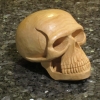We've been here before in other lessons on Woodcarving Workshops. In particular this stage of the rosette is quite similar to the start of the waterleaf moulding: essentially, simple cuts create a petal or leaf edge, then another set of simple cuts reveal a secondary petal or leaf in between. Can you see that the Rosette edge here is really the same sort of moulding, wrapped into a circle?
When it comes to ornamental or decorative carving, building up simple, repeated cuts into something that looks complicated is a fundamental idea. Carving is always done one cut at a time. It's where and when you put the cuts that matters.

| 15 July 2014 16:01
Chris, well I'm sure I'm not the first person who needed to see things several times and then with practice, something finally "clicked"! I watched again carefully in this video when you "chip" carved around the petals. On my rather deep relief project, I started looking at my hands, my weight, and with the right tools working well, especially the fishtail, and concentrating on taking advantage of its corners: a little "eureka!" - I'm getting it! Thanks as always!!

| 12 July 2014 20:50
Ann - It's wood, and that's hard and, yes, you need to develop a degree of muscle strength, especially since you are using muscles you are not using for anything else. I don't think there is really any way round that, but it would be the same if, for example, you took up tennis or something else that needed specific muscles. So exercises to increase upper body, arm and wrist strength will help. On the other hand, correctly sharpened tools - with the long bevel and thus thin wedge will make carving less hard work; as will a mallet! More than anything, use your body weigh: When you see me carving, you'll often notice I keep my arms/elbows in to my body. With the low angle grip I rotate my body with the movement and behind the cut, rather than just using my arm muscles. With the high angle grip, I often have the handle in close to my shoulder so I can add my body weight to the downward movement. It's martial art-like in that way; working from your centre, and up from the floor even.

| 12 July 2014 20:37
Ann - If you think of a fishtail chisel that you might use for lettering, straight edge, bevel both sides, but with the edge skewed at an angle, then you have the 'fishtail skew chisel'. The advantage lies in the even-more-accentuated corner than your regular skew chisel. A' winged' tool - gouge or chisel - has BOTH corners pronounced, so the cutting edge is pulled back in the middle; normally gouge or chisel corners are square giving you a straight-across cutting edge.

| 09 July 2014 15:14
A question I've had for a while: not wanting to be a wimp-with-excuses, but I have nowhere your strength in my hands and in particular my thumbs. I find it hard to do good slicing but especially the pen-and-dagger hold. Do you have any suggestions? :(

| 08 July 2014 11:15
Chris, thanks so much for the wonderful demonstration of fine detailing in a tight place. Hope to be able to put it to good use. One question: is a fishtail skew the same as a fishtail or winged gouge?

| 24 June 2014 16:17
Derek - Yes, my fishtail skew was one I modified from a fishtail chisel years ago. It does seem a little drastic but once done it'll last you a lifetime and the fishtail effect give a good projection to the long point. I simply got a 14mm fishtail chisel (Taylor or Pfeil would do) and set the edge to an angle, rather than square on as usual, then sharpened it. Take especial care not to overheat the long point and turn it blue! I think we'll make a video on this in the future - I've actually tended not to show my own skew on the site because I don't think anyone would have it. I do know the Gonzalez skew but prefer my own version, which seems more robust. The Pfeil one I don't know...

| 23 June 2014 03:27
Hello Chris,
I can see the usefulness of a fishtail-type skew chisel (referring to the one you showed & used in the above video. I'm wondering if that tool is one you've made by modifying a regular fishtail or are there any manufacturers who make them? I can't seem to find that option in any of the several top makers of carving tools I purchase from. I am aware of the Abegglen detail tool available from Pfeil (& have one - very useful) & also the Ray Gonzales Hooked Skew tool but find the curvature of those tools is sometimes an impediment in certain situations when a fishtail type skew would be the perfect tool for the situation.
Would I have to modify a regular flat fishtail of are you aware of any firms who offer that type of skew, Sorry for the lengthy comment/question.
Excellent instruction, projects & videography (thanks Carrie, great work).
Thank you,
Derek